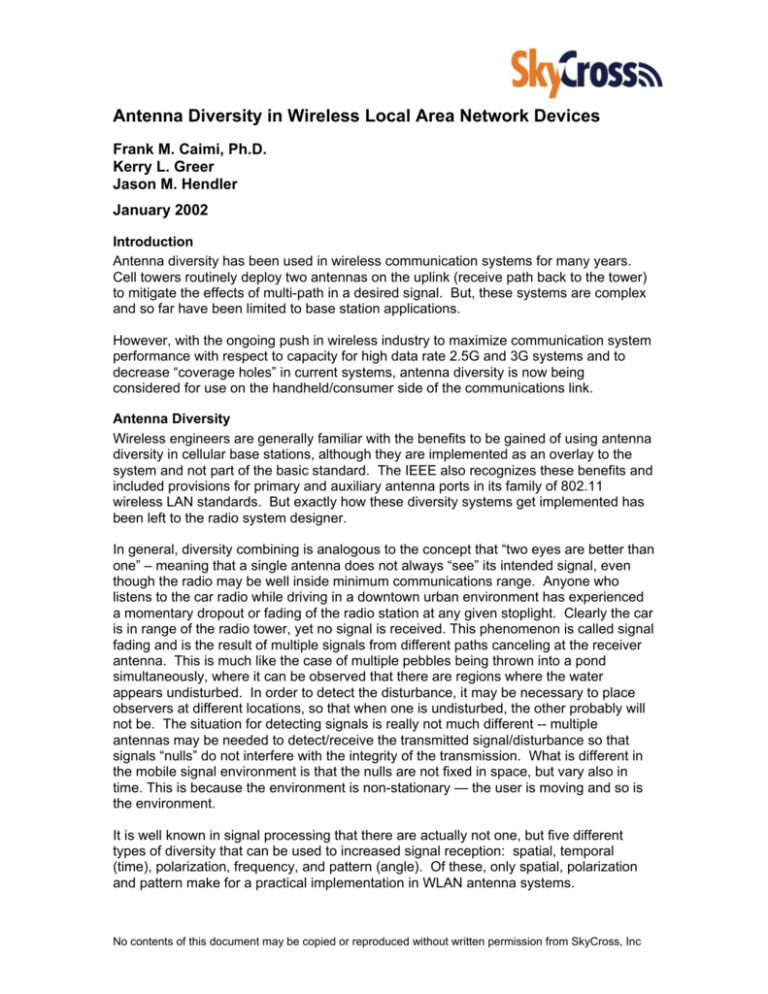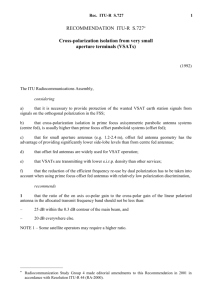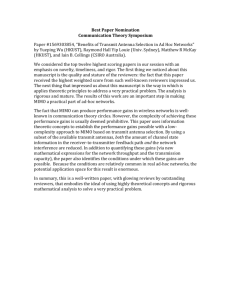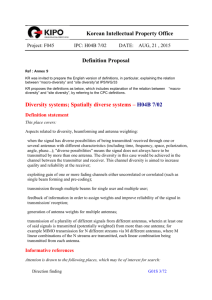Antenna Diversity in Wireless Local Area Network Devices
advertisement

Antenna Diversity in Wireless Local Area Network Devices Frank M. Caimi, Ph.D. Kerry L. Greer Jason M. Hendler January 2002 Introduction Antenna diversity has been used in wireless communication systems for many years. Cell towers routinely deploy two antennas on the uplink (receive path back to the tower) to mitigate the effects of multi-path in a desired signal. But, these systems are complex and so far have been limited to base station applications. However, with the ongoing push in wireless industry to maximize communication system performance with respect to capacity for high data rate 2.5G and 3G systems and to decrease “coverage holes” in current systems, antenna diversity is now being considered for use on the handheld/consumer side of the communications link. Antenna Diversity Wireless engineers are generally familiar with the benefits to be gained of using antenna diversity in cellular base stations, although they are implemented as an overlay to the system and not part of the basic standard. The IEEE also recognizes these benefits and included provisions for primary and auxiliary antenna ports in its family of 802.11 wireless LAN standards. But exactly how these diversity systems get implemented has been left to the radio system designer. In general, diversity combining is analogous to the concept that “two eyes are better than one” – meaning that a single antenna does not always “see” its intended signal, even though the radio may be well inside minimum communications range. Anyone who listens to the car radio while driving in a downtown urban environment has experienced a momentary dropout or fading of the radio station at any given stoplight. Clearly the car is in range of the radio tower, yet no signal is received. This phenomenon is called signal fading and is the result of multiple signals from different paths canceling at the receiver antenna. This is much like the case of multiple pebbles being thrown into a pond simultaneously, where it can be observed that there are regions where the water appears undisturbed. In order to detect the disturbance, it may be necessary to place observers at different locations, so that when one is undisturbed, the other probably will not be. The situation for detecting signals is really not much different -- multiple antennas may be needed to detect/receive the transmitted signal/disturbance so that signals “nulls” do not interfere with the integrity of the transmission. What is different in the mobile signal environment is that the nulls are not fixed in space, but vary also in time. This is because the environment is non-stationary — the user is moving and so is the environment. It is well known in signal processing that there are actually not one, but five different types of diversity that can be used to increased signal reception: spatial, temporal (time), polarization, frequency, and pattern (angle). Of these, only spatial, polarization and pattern make for a practical implementation in WLAN antenna systems. No contents of this document may be copied or reproduced without written permission from SkyCross, Inc Temporal diversity involves lining up and comparing multiple signals and choosing the one that best matches the expected time of arrival for a signal. This concept is sometimes used in digital receivers when a fixed Line of Sight (LOS) communication is feasible, but in any case it is not part of the antenna. Any system that uses a portion of the available band can incorporate frequency diversity. Frequency diversity relies on the fact that phase cancellation of a signal is frequency dependent. Although a null may be present at one frequency band, it may not at another. An intelligent controller can assign frequency slots dynamically to avoid signal-canceling fades. The method is not viable however, if the communications standard does not support frequency channelization; for instance in full bandwidth CDMA systems, frequency diversity is not feasible. Furthermore, frequency diversity has effectively already been taken into account in WLAN systems, since by definition the individual data links are “channelized” in that they typically use a pre-determined 6 MHz sub-channel to isolate different networks form one another. This leaves spatial, pattern and polarization as diversity options for WLAN, which still provides significant gains as detailed below. Spatial Diversity Spatial diversity is the most widely implemented form of diversity combining. Referring to the car radio example above, the temporary loss of radio signal at a stoplight is due to multi-path interference. As the radio signal propagates through the urban landscape, the signal bounces off buildings and other structures. This scatters the signal in many directions, producing multiple copies of the signal. As the radio is tuned to the specific frequency of interest, it receives all these copies of signal together. Since reflected signals traverse a farther distance path from tower to radio than a direct signal, the multiple signals are no longer in phase with each other. In fact, they are now in random phase. Multiple signals that are in-phase will add to reception, while signals out of phase will cancel each other. As a result, the multiple signals will periodically cancel each other and reception is lost. Spatial diversity mitigates this problem by using two similar receive antennas separated by a fixed number of wavelengths. Given that the multi-path interference is localized to a specific location (such as antenna #1), antenna #2 will not suffer the same degradation. The separation spacing is chosen specifically to maximize the reception of antenna #2 when antenna #1 is at minimum. Therefore, in the simplest implementation, the radio simply switches to whichever antenna is currently receiving the strongest signal. More complex systems utilize different forms of signal combining based on weighting according to the signal-to-noise ratio of each of the received signals (Maximal Ratio Combining) or according to equal weighting (Equal gain Combining). In either case the signals are co-phased and summed. SkyCross WLAN antennas implement spatial diversity by locating two antennas on the WLAN circuit board. Pattern Diversity Pattern diversity (or angle diversity) is conceptually easy to understand. Antennas come in all shapes and sizes. Part of this variety is due to the desired beam pattern they produce. For example, large parabolic dish antennas produce a very high gain beam pattern that is narrowly focused in one particular direction (usually pointed toward a geosynchronous satellite in space). If the antenna is not perfectly aligned, the signal drops. This is a form of pattern diversity in which the transmitter (the satellite) and the receiver (the dish) are fixed in position. In WLAN systems however, the mobile unit is not fixed in position. If fact, the adoption of WLAN systems is predicated on mobility, allowing the user to connect his/her laptop from anywhere (i.e. any angle, including straight above). So conceptually, the mobile unit would best be configured with a hemispherical antenna allowing connection in any direction above the horizontal plane of the device. The problem comes from the fact that it is not easy to design an antenna with a hemispherical pattern, especially one that has positive gain throughout the entire hemisphere of interest. To overcome this problem, SkyCross has designed a pattern diversity system for WLAN which implements different beam patterns on the two different antennas. Referring to Figure 1 below, the yellow antenna is designed to produce an omni-directional toroid pattern (looks like a donut) with maximum gain in a horizontal circle direction around the device. The blue antenna is designed to produce a unidirectional cone-shaped pattern with maximum gain focused at zenith straight overhead from the device. Again the receiver switches between antennas depending on which one has the strongest signal. SkyCross WLAN antennas implement this pattern diversity with the same two antennas on the WLAN circuit board. This combination results in a higher overall gain pattern throughout the entire upper hemisphere than could be achieved with two similarpatterned antennas. Figure 1. Pattern Diversity Example Polarization Diversity The third type of diversity combining that can be used to increase WLAN system performance is polarization. Polarization is a naturally occurring consequence of electromagnetic waves bouncing off some surface. In fact polarized sunglasses make use of this fact when blocking sunlight glare off of water. Sunlight is naturally polarized both horizontally and vertically. As sunbeams hit the water surface, the verticallypolarized beams are absorbed by the water and the horizontally-polarized beams are reflected. Polarized sunglasses are built then to block horizontally-polarized reflected light only, resulting in a filter for glare off the water while still passing other light sources. Electromagnetic waves in free space travel in a direction that is perpendicular to the direction(s) of oscillation of their associated electric and magnetic fields. For example, if an RF wave is traveling in the z-direction, the electric field could be oscillating in either (or both) the x- and/or y-directions (referred to as the horizontal and vertical directions). As this wave encounters other structures, it bounces off and produces multiple copies as detailed above in the spatial diversity section. However, in addition to the now random phase of the multiple received signals, the reflected signals also exhibit changed polarization. Therefore, both a horizontally- and vertically-polarized receiver system is optimal for WLAN. Referring to Figure 2 below, SkyCross WLAN antennas implement this polarization diversity again with the same two antennas on the WLAN circuit board. This combination results in a dual-polarized system that can exhibit up to 3 dB better reception than a system that is linearly-polarized in just one dimension. Figure 2. Polarization Diversity Example Conclusion SkyCross is implementing its multi-dimensional diversity system in WLAN applications to achieve system gains beyond traditional configurations. SkyCross has patent-pending product samples available which demonstrate these concepts designed to fit on the end of a PCMCIA cards. Please refer to (WLAN LINK) for product details.





